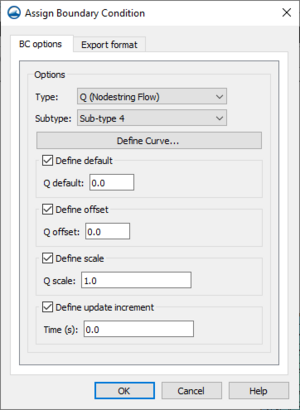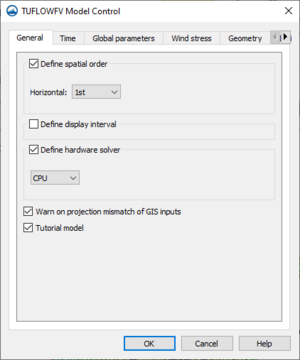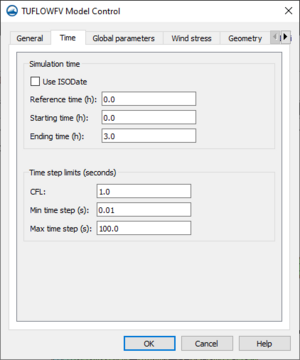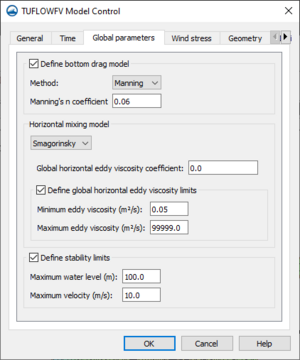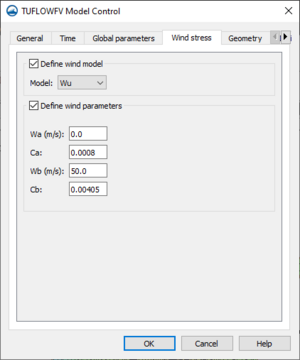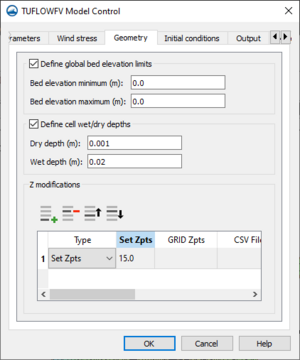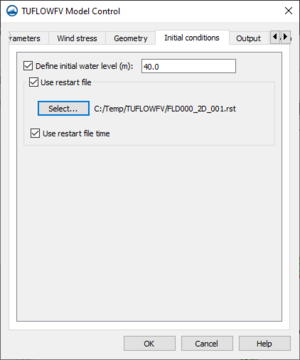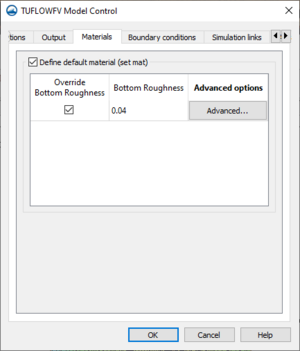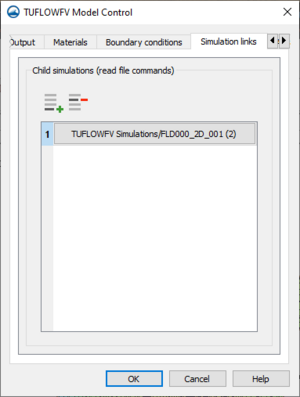User:Jcreer/TUFLOW FV for SMS 13.2: Difference between revisions
| Line 483: | Line 483: | ||
**''Boundaries'' – | **''Boundaries'' – | ||
***'''Define Bcs...''' – Opens ''Add Gridded BCs'' dialog. | ***'''Define Bcs...''' – Opens ''Add Gridded BCs'' dialog. | ||
***''Add Gridded BCs'' – | |||
**** [[File:Row-add.svg|pi|16 px]]'''Add row''' – | |||
**** [[File:Row-delete.svg|pi|16 px]]'''Delete row''' – | |||
****''Type'' – | |||
****''Attributes'' – | |||
*****'''Assign BC...''' – Opens ''Assign Gridded Boundary Condition'' dialog. | |||
******''Options'' – | |||
*Global wave options | *Global wave options | ||
**Include wave stress | **Include wave stress | ||
Revision as of 19:19, 10 February 2022
| TUFLOW FV | |
|---|---|
| Model Info | |
| Model type | Two-dimensional (2D) flexible mesh finite volume flood, tide and water quality simulation software. |
| Developer | WBM BMT WBM (Australia) |
| Web site | www.tuflow.com |
| Tutorials | SMS Learning Center |
TUFLOW FV (which stands for Two-dimensional Unsteady FLOW Finite Volume) is a flexible mesh finite volume numerical model that simulates hydrodynamic, sediment transport and water quality processes in oceans, coastal waters, estuaries and rivers. The model may be used for coastal and nearshore environments including beaches and coastlines as well as offshore environments such as estuaries, river entrances and deltas, and floodplains. Uses include modeling river flood flow, tsunami inundation (the finite-volume scheme is well suited for a tsunami's mixed sub/super-critical flow regimes), beach erosion, ocean pollution, and estuary flow.
Unlike the fixed square grids of TUFLOW Classic, the flexible triangular or quadrilateral mesh of TUFLOW FV allows users to modify mesh resolution spatially, seamlessly increasing the model resolution in areas of interest. This modelling approach reduces the number of computation cells needed in a model reducing run times. Additionally, TUFLOW FV can be run in parallel on multiple processors, threads, or computers.
The TUFLOW FV model can be added to a paid edition of SMS.
TUFLOW FV ENGINE
The TUFLOW computational engine computes 2D hydraulic solutions. The engine uses a macro style text-file input which allows the user to flexibly and efficiently control model configurations and simulations.
For more information see the TUFLOW FV webpage.
SMS Interface
The TUFLOW FV engine is interfaced in SMS through the generic model interface.
TUFLOW FV Coverages
TUFLOW FV simulations require a boundary condition coverage and a materials coverage.
Boundary Conditions Coverage
The TUFLOW FV boundary conditions coverage allows assigning boundary condition attributes to arcs drawn in the coverage. These attributes will then be assigned, or snapped, to the 2D mesh during the simulation run.
Attributes are assigned to arcs by right-clicking a selected arc and selecting the Assign BC command. This will open the Assign Boundary Condition dialog for TUFLOW FV.
The TUFLOW FV Assign Boundary Condition dialog has the following options:
BC Options – The BC Options tab has options for assigning attributes to the arc.
- Type – The option here determines what type of boundary condition will be assigned to the arc. The following types are available:
- "Monitor" – Sets the arc to be a monitoring line.
- "HQ (Head Discharge)" –
- "Q (Nodestring Flow)"
- "QN (Head Discharge)"
- "WL (Water Level)"
- "WLS (Sloping Water Level"
- "WL_CURT (Water Level Curtain"
- "ZG (Zero Gradient)"
- Subtype
- Define Curve
- Friction slope
- Dataset file
- Define Varaibles
- View Curve
- Define default
- 'Q default
- Define offset
- Q offset
- Define scale
- Q scale
- Define update increment
- Time
- Include mean sea level pressure
Materials
The TUFLOW FV materials coverage allows creating the polygons to hold the material attributes for the simulation run. The assigned material attributes will be mapped to the mesh/grid during the simulation run.
TUFLOW FV Simulation Menu
The TUFLOW FV simulation item in the Project Explorer contains a right-click menu with commands for accessing TUFLOW FV simulation options. The menu has the following commands:
- Simulation Run Queue – Opens the Simulation Run Queue dialog.
- Model Control – Opens the TUFLOWFV Model Control dialog.
- Save Simulation – Saves the simulations and exports the simulations files needed for the simulation run.
- Run Simulation – Runs the simulation using the exported simulation files. will bring up the Simulation Run Queue dialog.
- Save Project, Simulation and Run – Exports the simulation files, saves the project and project files, and runs the simulation. Will bring up the Simulation Run Queue dialog.
- Read Solution – Opens a browser to import the solution files.
- Simulation Properties – Opens the Simulation Propertes dialog where basic information about the simulation can be viewed.
The specific menu commands may be different depending on the selected option in the Preferences dialog.
TUFLOW FV Model Control
The TUFLOW FV Model Control dialog contains options for setting the parameters that will be used during the simulation run. The dialog is accessed by right-clicking on the simulation in the Project Explorer and selecting the Model Control command. The dialog contains multiple options organized on multiple tables. The options are as follows:
General
The General tab of the TUFLOW FV Model Control dialog contains the following options:
- Define spatial order – (Option to define horizontal spatial scheme??)
- Horizontal – Select "1st" order scheme or "2nd" order scheme.
- Define display interval – (Does it have something to do with the output interval. Time steps???)
- Display interval
- Define hardware solver – Option to enable computing through the CPU or the GPU. Can produce slight differences in results.
- "CPU" – Calculations will use the "Central Processing Unit".
- "GPU" – Calculations will use the "Graphical Processing Unit". Using GPU with TUFLOW
- Device ID – Option to select which GPU device is used for computers or GPUs with multiple CUDA enabled GPU cards.
- Warn on projection mismatch of GIS inputs – (Sets the program to warn if GIS inputs are not all in the same projection??)
- Tutorial model – (Allows simulation of the TUFLOW Tutorial Models without the need for a TUFLOW license.??)
Time
The Time tab of the TUFLOW FV Model Control dialog contains the following options:
- Simulation time
- Use ISODate – Option to use ISODate format which requires data be input in the form dd/mm/yyyy HH:MM:SS. If left off, default time format is hours.
- Reference time – Will set simulation reference time. Times set for starting and ending have reference to this time. This can affect output times when processing and visualizing results from certain programs.
- Starting time – Will set simulation start time.
- Ending time – Will set simulation end time.
- Time step limits
- CFL – Sets the Courant-Friedrichs-Lewy condition. ((This is a control number that gives the model...???)). Can be no larger than one since this is the theoretical stability limit. Often, inputting a value lower than one ensures greater model stability.
- Min time step(s) – ""Specifies minimum variable timestep allowed according to CFL stability criterion""
- Max time step(s) – ""Specifies maximum variable timestep allowed according to CFL stability criterion""
Global parameters
The Global parameters tab of the TUFLOW FV Model Control dialog contains the following options:
- Define bottom drag model – Option to specify bottom drag model for the simulation. The bottom drag model will be used to describe ((bed boundary resistance??)) in the simulation.
- Method – Option to set bottom drag model to use "Manning" or "KS".
- "Manning" – Uses the Manning model and requires a Manning's n coefficient
- Manning's n coefficient – Sets the Manning's n coefficient.
- "KS" – ""Assumes a log-law velocity profile and requires specification of a surface roughness length-scale. Requires "ks" values be set.""
- Nikuradse roughness – Sets the Nikuradse roughness for the bottom drag model.
- "Manning" – Uses the Manning model and requires a Manning's n coefficient
- Method – Option to set bottom drag model to use "Manning" or "KS".
- Horizontal mixing model – ((??Possible Scalar mixing model)) ((Momentum mixing model...?)) Defines horizontal mixing eddy viscosity calculation according to options in drop-down menu.
- "None" – Will not represent horizontal momentum mixing.
- "Constant" – Option to globally define a specific constant eddy viscosity (ft2/s).
- Global horizontal eddy viscosity – Specifies the constant eddy viscosity ((for the entire simulation??).
- "Smagorinsky" – The horizontal eddy viscosity will be calculated according to the Smagorinsky model which sets the diffusivity proportional to the local strain rate. Requires specification of global horizontal eddy viscosity coefficient.
- Global horizontal eddy viscosity coefficient – Sets the Smagorinsky coefficient for the horizontal mixing eddy viscosity calculation.
- Define global horizontal eddy viscosity limits – Sets globally ((for the entire simulation??) the limits for the horizontal eddy viscosity ((values??)). Only for use with Smagorinsky or Wu models.
- Minimum eddy viscosity – Sets the minimum horizontal eddy viscosity in ft2/s.
- Maximum eddy viscosity – Sets the maximum horizontal eddy viscosity in ft2/s.
- "Wu" – The horizontal eddy viscosity will be calculated according to the Wu model. Requires specification of global horizontal eddy viscosity coefficient. ((Seems to be a wind stress model. Can't figure out what it has to do with the Horizontal Mixing model did it get included here by accident??))
- Global horizontal eddy viscosity – Sets the Wu coefficient for the horizontal mixing eddy viscosity calculation.
- Define global horizontal eddy viscosity limits – Sets globally ((for the entire simulation??) the limits for the horizontal eddy viscosity ((values??)). Only for use with Smagorinsky or Wu models.
- Minimum eddy viscosity – Sets the minimum horizontal eddy viscosity in ft2/s.
- Maximum eddy viscosity – Sets the maximum horizontal eddy viscosity in ft2/s.
- Define stability limits – Option to define the maximum acceptable values relevant for the model. If water level or velocity exceed the given values, the model will stop computations and give an error. This feature helps to identify a model with instabilities by recognizing unrealistic values that the model produces. Small anomalies and acceptable spikes in data values will not stop computations.
- Maximum water level – Sets maximum acceptable water level for the model.
- Maximum velocity – Sets maximum acceptable velocity for the model.
Wind stress
The Wind stress tab of the TUFLOW FV Model Control dialog contains the following options:
- Define wind model – Option to define the model used in calculating wind stress for any wind inputs in the simulation.
- Model – Drop-down menu with options for models that can be used to calculate wind stress.
- Wu – Sets the wind stress model to the Wu model. Scales wind stress parameterisation based on wind speed.
- Constant – Applies wind stress parameterisation using Bulk momentum transfer coefficient as in pre-2019 builds of TUFLOW.
- Kondo – Applies a scaling factor ((for the wind stress parameters??)) using a single term.
- Model – Drop-down menu with options for models that can be used to calculate wind stress.
- Define wind parameters – ((Sets the ((??Wind Drag Coefficients)) parameters that the selected model will use to scale the wind stress parameterisation??))
- Wa – ((??Wind speed in feet per second))
- Ca –
- Wb –
- Cb –
- Bulk momentum transfer coefficient – sets the coefficient for the Constant wind stress model.
- Scale factor – Sets the scaling factor for the Kondo wind stress model.
Geometry
The Geometry tab of the TUFLOW FV Model Control dialog contains the following options:
- Define global bed elevation limits – Option to apply bed elevation limits ((to the entire model??)). This truncates the bathymetry to be within certain values. Bed elevations in the model that are outside the set limits will be set to the minimum or the maximum. INCLUDE??""This is commonly used to sensitivity test limits, or to enforce wet elements where coarse mesh resolution has resulted in spurious wetting/drying areas. ""
- Bed elevation minimum – Defines minimum bed elevation. ((Bed Elevations??Maybe just elevations)) in the model below this value will be set to this value.
- Bed elevation maximum – Defines maximum bed elevations. ((Bed Elevations??Maybe just elevations)) in the model above this value will be set to this value.
- Define cell wet/dry depths – Sets the depth limits that define certain attributes of cells in the model.
- Dry depth – Sets a minimum depth value below which the simulation drops a cell from ((computations/calculations??), ((being considered "dry"))
- Wet depth – Sets a minimum depth value below which the simulation sets a cell's momentum to zero ""to avoid unphysical velocities at very low depths""
- Z modifications – ((Options for adjusting elevation data??))
- Add Row
 Adds a row of elevation data to the Z modifications table.
Adds a row of elevation data to the Z modifications table. - Delete Row
 Deletes the selected row of elevation data from the Z modifications table.
Deletes the selected row of elevation data from the Z modifications table. - Move up
 Moves the selected row of elevation data to be above the row immediately above it.
Moves the selected row of elevation data to be above the row immediately above it. - Move down
 Moves the selected row of elevation data to be below the row immediately below it.
Moves the selected row of elevation data to be below the row immediately below it. - Type – Option to select which type of elevation input is desired on this row of data.
- Add Row
(( **Set Zpts – ((Sets elevation values for the center of the cells to the given value.??))
- GRID Zpts – Interpolates a grid file to set mesh cell center elevations. Select (none selected) to open a dialog box and select the desired grid file. Either .asc or .flt. can be used for this feature.
- CSV File – Option to update cell elevations using a .csv file. The .csv file can identify cells using x,y coordinates or cell IDs.
- CSV Type – Select which type of data the .csv file will contain.
- Cell ID – Sets the program to read the .csv file data for cell IDs matched with elevation data.
- Coordinate – Sets the program to read the .csv file data for x,y coordinates matched with elevation data.
- ZLine Shapes – Sets breakline features and polygon features according to an already imported .shp or ((.mif/.mid??)) file. Select (none selected) to open a dialog and select the desired file.
- ZPoint Shapes – Sets elevation points according to an already imported .shp or ((.mif/.mid)) file. Select (none selected) to open a dialog and select the desired file. ??))
Initial conditions
The Initial conditions tab of the TUFLOW FV Model Control dialog contains the following options:
- Define initial water level – Option set water level to a constant value for the entire simulation. It's best for the water level boundary conditions for the initial timesteps to be as close as possible to this setting.
- Use restart file – Option to use a restart file to define ((the initial conditions??)) for the current run. Restart files will only function for models with the ""same mesh, bathymetry, vertical layering, and number of conserved variables"".
- Select – Opens dialog box for selecting restart file to be used.
- Use restart file time – Option to use the time stamp on the restart file as the starting time of the current run. On by default.
Output
The Output tab of the TUFLOW FV Model Control dialog contains the following options:
- Output blocks – ""Output blocks specify the type of output and the output properties including the desired parameters and time definitions""
 Add Row – Adds a output block to the Output blocks table.
Add Row – Adds a output block to the Output blocks table. Delete Row – Deletes the selected output block from the Output blocks table.
Delete Row – Deletes the selected output block from the Output blocks table.- "DATV" – ((SMS will give mapped output in DATV format with user specified datasets and parameters. Often used for data visualization in SMS.??))
- Define Interval – Option to set the interval for the specified output in seconds. If not specified, the program will produce the specified output at every timestep, sometimes resulting in output files that are too large.
- Define start time – Sets output request start time. When not specified, the output start time will be the simulation start time. Time format will be the same as format selected under the Time tab.
- Define final time – Sets output request final time. When not specified, the output final time will be the simulation end time. Time format will be the same as format selected under the Time tab.
- Define Statistics – Option to track minimum and/or maximum values of selected datasets ((call them model parameters??)).
- Type – Select the values to track from the drop-down menu.
- "Both" – Both maximum and minimum values for selected datasets will be tracked.
- "Minimums" – Only minimum values for selected datasets will be tracked.
- "Maximums" – Only maximum values for selected datasets will be tracked.
- Define statistics dt – Option to define independent output interval for tracking of minimum and maximum values. If not defined, defaults to 0 and uses the model interval.
- Type – Select the values to track from the drop-down menu.
- Filename suffix – ((Option to specify a desired suffix for output file.??))
- Datasets – ((Specify datasets for inclusion in output file??)) ((It seems that these are all the possible parameters that banc be included in the output files. So that's what they mean when they say "model parameters"))
- Water depth – Turns on water depth for output file
- Water surface elevation –
- Bed Shear stress –
- Surface shear stress –
- Velocity vector and magnitude –
- Velocity magnitude only –
- Bed elevation –
- Turbulent viscosity –
- Evaporation rate –
- Flood hazard category based on the Australian NSW Flood plain management Manual (NSWG, 2005) –
- Flood hazard category as outlined by Australian Emergency Management Institute in 2014 –
- Hazard categories for the Queensland Reconstruction Authority –
- Mean sea level pressure –
- Downward short-wave radiation flux –
- Temperature –
- 10 m wind speed vector –
- Wave height – typically significant wave height –
- Wave period – typically peak wave period –
- Wave direction –
- Wave stress vector –
- "XMDF" – ((SMS will give mapped output in XMDF format with user specified datasets and parameters. OFten used for data visualization in SMS.??))
- Define compression – ((Option to compress output file. Potentially useful for large models or tight storage space.??))
- Compression on – If turned on, output file will be compressed. On by default.
- Define compression – ((Option to compress output file. Potentially useful for large models or tight storage space.??))
- "NetCDF" – ((SMS will give mapped output in NetCDF (network Common Data Form) format with user specified datasets and parameters. Includes information about the model geometry, mapped output, and the specified time interval ??))
- "Flux" – Outputs a CSV file ""with flux across all model nodestrings."" This information might be used to check rates of fluid and other ""simulated quantities that enter or exit the model boundaries or cross user specified nodestrings in the model domain. In SMS, I don't know how to define other simulated quantities.
- "Mass" – Outputs a CSV file that can be used to check certain simulated quantities, mainly the volume of fluid within the model domain.
- "Points" – Outputs a CSV file containing model parameter time-series. This includes coordinates and associated data for the points of interest ((as defined in a coverage dedicated to this task.??))
- Output points feature coverage – Select desired coverage to define output points coordinates.
- "Transport" – Outputs a NetCDF file ""with conserved variables stored on the TUFLOW FV mesh to be used in subsequent advection-diffusion, sediment, or particle tracking simulations."" This file is a special type of boundary condition used to improve runtimes for those simulations.
- Output block options - Row (value of selected row) – ((Gives options to define ((parameters??)) and datasets for the selected row depending on the selected output type.??))
- Directories –
- Log directory – Option to specify ((directory??)) for simulation log file (.log) output. When not specified, log file will be written to same location as simulation control file.
- Output directory – Option to specify location in which simulation output files will be written. When not specified, output files will be written to same location as simulation control file.
- Write restart file – ((??Couldn't find command instructions?? Option to write restart file for the current simulation. "This will save current values of the selected datasets in each cell at regular timesteps". Specify these timesteps in Write restart dt.
- Write restart dt – Specify the desired interval of timesteps at which TUFLOW FV will write the restart file.
- Enable restart overwrite – Option to overwrite the restart file being used at the time interval specified in Write restart dt. On by default.
- Write check files – Option to create a number of check files that can be used to verify model inputs.
- Check files directory –
- Write empty GIS files – Option to automatically create GIS template files in .mid/.mif or .shp format with recommended GIS naming conventions that "contain the correct GIS attributes".
- Template files directory – Sets the location in which the empty GIS files will be written.
| Output dataset options available with output blocks DATV, XMDF, NetCDF, and points | Description |
|---|---|
| Water depth | |
| Water surface elevation | |
| Bed shear stress | |
| Surface shear stress | |
| Velocity vector and magnitude | |
| Velocity magnitude only | |
| Bed elevation | |
| Turbulent viscosity | |
| Evaporation rate | |
| Flood hazard category based on the Australian NSW Flood plain management Manual (NSWG, 2005) | |
| Flood hazard category as outlined by Australian Emergency Management Institute in 2014 | |
| Hazard categories for the Queensland Reconstruction Authority | |
| Mean sea level pressure | |
| Downward short-wave radiation flux | |
| Temperature | |
| 10 m wind speed vector | |
| Wave height – typically significant wave height | |
| Wave period – typically peak wave period | |
| Wave direction | |
| Wave stress vector |
| Output Dataset Option | Description | Output blocks with this option |
|---|---|---|
| Water depth | DATV, XMDF, NetCDF, Points | |
| Water surface elevation | DATV, XMDF, NetCDF, Points | |
| Bed shear stress | DATV, XMDF, NetCDF, Points | |
| Surface shear stress | DATV, XMDF, NetCDF, Points | |
| Velocity vector and magnitude | DATV, XMDF, NetCDF, Points | |
| Velocity magnitude only | DATV, XMDF, NetCDF, Points | |
| Bed elevation | DATV, XMDF, NetCDF, Points | |
| Turbulent viscosity | DATV, XMDF, NetCDF, Points | |
| Evaporation rate | DATV, XMDF, NetCDF, Points | |
| Flood hazard category based on the Australian NSW Flood plain management Manual (NSWG, 2005) | DATV, XMDF, NetCDF, Points | |
| Flood hazard category as outlined by Australian Emergency Management Institute in 2014 | DATV, XMDF, NetCDF, Points | |
| Hazard categories for the Queensland Reconstruction Authority | DATV, XMDF, NetCDF, Points | |
| Mean sea level pressure | DATV, XMDF, NetCDF, Points | |
| Downward short-wave radiation flux | DATV, XMDF, NetCDF, Points | |
| Temperatre | DATV, XMDF, NetCDF, Points | |
| 10 m wind speed vector | DATV, XMDF, NetCDF, Points | |
| Wave height – typically significant wave height | DATV, XMDF, NetCDF, Points | |
| Wave period – typically peak wave period | DATV, XMDF, NetCDF, Points | |
| Wave direction | DATV, XMDF, NetCDF, Points | |
| Wave stress vector | DATV, XMDF, NetCDF, Points |
Source Stuff
Datv (recommended for visualisation in SMS and QGIS). • XMDF (recommended for visualisation in SMS and QGIS). • Flux (time series of fluxes across all nodestrings, refer Section 17.5). • Mass (time series mass in model refer Section 17.5). • NetCDF (cell centred 2D and 3D output, used heavily for 3D model visualisation, refer Section 17.6.4). • Points (time series outputs, refer Section 17.3). • Transport (TUFLOW FV file used for decoupling hydrodynamics from following advection dispersion, sediment or water quality simulations, refer Section 15.8).
The TUFLOW FV ‘DATV’ or ‘XMDF’ options provide output on the mesh nodes at the specified output
time interval.
The TUFLOW FV 2D ‘points’ option provides model parameter time-series at point locations, each defined by a x, y coordinate specified within an output points file.
A file containing the conserved variables stored on the TUFLOW FV mesh to be used in a subsequent advection-diffusion, sediment or particle tracking simulation. Outputs a NetCDF file with conserved variables stored on the TUFLOW FV mesh to be used in subsequent simulations.
Materials
The Materials tab of the TUFLOW FV Model Control dialog contains the following options:
- Define default material (set mat) – ((??""Sets the material ID at all cells in the model domain.""
- Override Bottom Roughness
- Bottom Roughness
- Advanced Options
- Define horizontal eddy viscosity
- Horizontal eddy viscosity
- Define bed elevations limits
- Minimum bed elevation
- Maximum bed elevation
- Spatial reconstruction
- Define horizontal eddy viscosity
Boundary conditions
The Boundary conditions tab of the TUFLOW FV Model Control dialog contains the following options:
- Define BC default update dt – Option to set the timestep for all boundary conditions to update. If unspecified, TUFLOW FV will interpolate values to each timestep. If specified, TUFLOW FV will keep all values after one update but before the next update at a constant value.
- BC default update dt – ((sets the time value of the timesteps that TUFLOW FV will interpolate to??))
- Run in transport mode – Option to run a simulation that includes a transport boundary condition. Transport files are a special kind of boundary coniditon which is a spe ""Any simulation that uses a transport bc""
- Transport BC file – Click Select... to set which transport file will be used in this simulation.
- Global boundaries
 Add row – Adds a
Add row – Adds a Delete row – Deletes a
Delete row – Deletes a- Type –
- Attributes –
- Assign BC – Opens the Assign Global Boundary Condition dialog.
- Options –
- Type –
- Subtype –
- "Sub-type 1"
- "Sub-type 2"
- Define Curve... – Opens "BC Curve Editor"
- Define reference time –
- Use ISODate –
- Reference time –
- Define reference time –
- Define default –
- Q/A default –
- Define offset –
- Q/A offset –
- Define scale –
- Q/A scale –
- Define update increment –
- Time –
- Includes mean sea level pressure –
- Gridded boundaries
 Add row –
Add row – Delete row –
Delete row –- Grid Definition –
- Define Grid... – Opens Define BC Grid dialog.
- Grid Definition –
- File – Click Select... to
- Name –
- NetCDF variables –
- X-Variable –
- Y-Variable –
- Z-Variable –
- Define vertical coordinate type –
- "Elevation" –
- "Depth" –
- "Sigma" –
- "Height" –
- Cell gridmap –
- Boundary gridmap –
- Suppress coverage warnings –
- Boundaries –
- Global wave options
- Include wave stress
- Include Stokes drift
Simulation links
The Simulation links tab of the TUFLOW FV Model Control dialog contains the following options:
 Add row – Brings up the Select Child TUFLOW FV Simulation dialog. In this dialog another TUFLOW FV simulation can be select to link as a child simulation to the current simulation.
Add row – Brings up the Select Child TUFLOW FV Simulation dialog. In this dialog another TUFLOW FV simulation can be select to link as a child simulation to the current simulation. Delete row – Unlinks the selected simulation.
Delete row – Unlinks the selected simulation.
Advanced
The Advanced tab of the TUFLOW FV Model Control dialog contains the option to include advanced options These options can be added in the text editor located in this tab. The text will be appended to the FVC file with the simulation is exported.
Using the Model / Practical Notes
A TUFLOW licence is not required to run a TUFLOW FV model.
External Links
SMS – Surface-water Modeling System | ||
|---|---|---|
| Modules: | 1D Grid • Cartesian Grid • Curvilinear Grid • GIS • Map • Mesh • Particle • Quadtree • Raster • Scatter • UGrid |  |
| General Models: | 3D Structure • FVCOM • Generic • PTM | |
| Coastal Models: | ADCIRC • BOUSS-2D • CGWAVE • CMS-Flow • CMS-Wave • GenCade • STWAVE • WAM | |
| Riverine/Estuarine Models: | AdH • HEC-RAS • HYDRO AS-2D • RMA2 • RMA4 • SRH-2D • TUFLOW • TUFLOW FV | |
| Aquaveo • SMS Tutorials • SMS Workflows | ||
